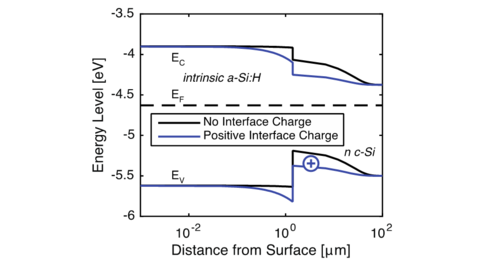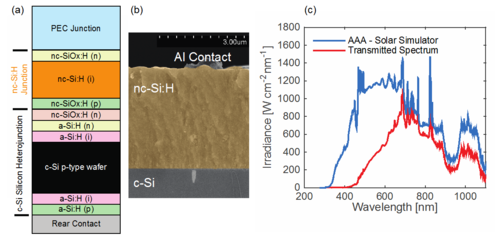FLASH Ravi
Interface Defects and Advanced Engineering of Silicon Heterojunction Solar Cells
Research is focussed on understanding the interface between amorphous silicon and crystalline silicon in silicon heterojunction solar cells. More specifically, this project has looked at the changes of minority carrier lifetime of crystalline silicon passivated with amorphous silicon due to light exposure and annealing. This project aims to understand more about the nature of these light induced and annealing induced changes that have thusfar in literature been linked to dangling bond generation at the interface. Work has shown that microstructure and cleaning parameters also play a role in interface charging during light exposure.

Other research in this project has looked at how to utilize silicon heterojunction technology for water splitting applications. Using the transmitted spectrum of photocathode devices such as silicon carbide, this research has shown that using a tandem device of a silicon heterojunction solar cell and a nanocrystalline silicon, thin film solar cell can achieve high solar-to-hydrogen efficiencies.

Table of contents
- Temperature Effects on the a-Si:H/c-SI Interface model using the Amphoteric Nature of Dangling Bonds
- Light Induced Effects of the a-Si:H/c-Si Interface
- The effect of doped layers on light induced effects on silicon heterojunctions
- The feasibility of FTPS on crystalline silicon solar cells
- A tandem nc-Si:H/Silicon Heterojunction solar cell designed for silicon based water splitting
Publications
R. Vasudevan, Z. Thanawala, L. Han, T. Buijs, H. Tan, D. Deligiannis, P. Perez-Rodriguez, I.A. Digdaya, W.A. Smith, M. Zeman, A.H.M. Smets, A thin-film silicon/silicon hetero-junction hybrid solar cell for photoelectrochemical water-reduction applications, Solar Energy Materials and Solar Cells, Volume 150, June 2016, Pages 82-87
FLASH
Subsidy:
Duration:
People involved: Prof. dr. Arno Smets, Ravi Vasudevan, Dorine van der Vlies, Zaid Thannawala, Isabella Poli

